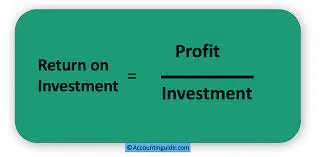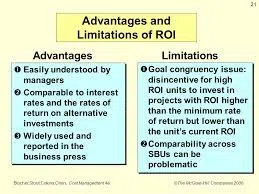Return on Investment is a quantity commonly used to estimate the performance or profitability of an investment. On the other hand, it is a measure used to compare the performance of different investments. An investor can calculate his income earned based on the expenses incurred for it.
Because of its straightforward computations, Return on Investment (ROI) is a common metric.
Return on Investment (ROI) can refer to stock investment, a factory expansion RO or the Return on Investment achieved by a real estate transaction, among other things. The Return on Investment is divided by the amount invested in computing the ROI, and a percentage or a ratio expresses the outcome. The ROI formula is a prominent measure used to calculate the ROI, and we can use it to determine how well a certain investment has done over time. Return on Investment does not consider the length of time spent keeping the asset, and as a result, it may undervalue the opportunity costs of investing elsewhere.
Did you know?
You should always check the best ROI before investing any money in the schemes. The best ROI will save your money and help you grow.
Also Read: Different Inventory Valuation Methods: What Are They?
What is the Return on Investment?
The Return on Investment does not have to be equal to the Return on interest. The efficiency measure used to estimate this is the ability to compare the performance of one investment or several different investments. ROI deals with the money you invest in a company and the income you receive from that money based on the business’s net profit. ROI is an attempt to directly measure the return on a particular investment relative to the investment’s price. ROI is a popular metric due to its versatility and simplicity. ROI can be a base measure of the Return on Investment. It could be the ROI of stock investment, the ROI of a company that expects to expand a factory or the ROI generated on a real estate transaction. If the ROI of the investment is net positive, it is worthwhile. But if there are other opportunities with higher ROIs, these signals will help investors eliminate or select the best options. Similarly, investors should avoid negative ROIs, which can mean net losses.
Because of its versatility and simplicity, Return on Investment (ROI) is one of the most widely used metrics. Overall, this high Return on Investment can be considered a basic indicator of the profitability and viability of an investment strategy. This could be a positive return on a stock investment, the overall Return on Investment a corporation expects from expanding a factory, or the total Return on Investment earned from a real estate deal, among other things.
Even while the best ROI calculation is not overly hard, it is also rather simple to interpret in light of the vast range of applications you can use the best ROI. If an investment’s good Return on Investment (ROI) is net positive, it is most likely a worthwhile investment. Nonetheless, if there are other chances with higher best ROIs accessible, these signals can assist investors in weeding out or selecting the best ROI alternatives. The same goes for investors, who should avoid negative Return on Investment (ROI), implying a net loss of this understanding of ROI.
How to Calculate ROI?
The ROI calculation is straightforward, and you can calculate it using one of the following two methods.
- The first is: ROI = frac { Text {Net Earnings Investment} { Text {Cost Investment Method 100 % ROI = Cost of Investment Return on Investment × 100%

- The second is: ROI = frac { Text Invest the final value of the investment} – Text Invest The initial value of the investment}} { Text Invest Investment cost}} times100 % ROI = The final value of the investment – the initial value of the investment × 100%
Explain the Meaning of ROI
Here are some things to keep in mind regarding ROI calculations:
As mentioned earlier, ROI is easier to understand when expressed as a percentage rather than a ratio. The ROI calculation has more to “net income” than “net profit or profit”. This is because the Return on Investment can often be negative rather than positive. A positive ROI means that net income is black because gross income is higher than total expenses. A negative ROI figure implies that the net income is in red (in other words, this investment creates a loss) because the total expenses outweigh the full returns. You should consider gross income and total expenses to calculate the ROI. For comparisons between competitive investments, you should consider the annual ROI.
What Are the Limitations of ROI?
Although investors use the planned ROI to estimate the value of the investment, the ROI formula is only one method of financial valuation. A major problem with the use of ROI is that it does not paint a complete picture of the economic landscape. ROI has two primary drawbacks:
- Choosing the company with the highest ROI when investing may seem straightforward, but since the risk is not considered a factor, ROI does not indicate how much money an investor loses. A higher ROI percentage usually shows a higher risk, and the investment market is more likely to fluctuate.
- ROI is not a time factor. When determining the potential value of an investment, it is important to know how much money will be invested over a while. However, returns on the investment formula do not have the factor of time required to realise capital gains.
For example, if you choose between two companies to invest in, where Company A offers a return of 25% and Company B a high return of 30%, you may select Company B above all else.
It is a good ROI. However, if Company A pays 25% over two years and Company B provides 30% over five years, Company A would be a better financier – that’s where the ROI formula falls.
Also Read: What is Management Accounting? Importance, Objectives and Types
The Advantages of ROI
- The biggest advantage of ROI is that it is not a complex metric, easy to calculate and intuitively easy to understand. The simplicity of ROI is a standardised, global measure of profitability that has the same meaning anywhere in the world and is therefore not responsible for misunderstandings. “20% ROI on this investment” has the same meaning as you would ask in Argentina or Zimbabwe.
- Despite its simplicity, the ROI metric is sufficient to evaluate the performance of a single investment or to compare the returns of different investments.
The Developments in ROI
Instantly, certain investors and businesses have taken an interest in the best development of an updated new form of the good ROI metric called “Social Return on Investment,” or SROI.
Understanding the value proposition of specific Environmental, Social and Governance (ESG) criteria used in Socially Responsible Investing (SRI) practices can aid in understanding the value proposition of particular ESG criteria.
Recently, a corporation may have decided to recycle water in its factories and replace all its lighting with LED lights that meet this Return on Investment calculation. There is an immediate expense associated with these endeavours, which may limit and negatively impact traditional ROI. Nevertheless, there may be a net benefit to society and the environment, resulting in a favourable SROI.
There have been several other new variations of total ROI developed for particular purposes. Also, this social media statistics ROI pinpoints the effectiveness of social media campaigns. Good ROI relates to the amount of information learned and retained as a return on education or skills training. As the world progresses and the economy changes, several other niche forms of total ROI will develop in the future of this developed ROI.
What Is a Good ROI?
What a good ROI qualifies as a “good or best” ROI will depend on factors such as the risk tolerance of the ROI investor and the time required for the total ROI investment to generate a full return. All else being equal, a good return on more risk-averse investors will likely accept lower ROIs to take less risk. Likewise, a good Return on Investments that take longer to pay off will generally require a higher Return on Investments to be attractive to investors of this good ROI.
Conclusion
This is about how to track your investments by ROI calculation. It discusses how easy it is to attract high potential ROIs. However, there is no sequence of dangers in the calculations, so you have to walk carefully.
When making any moves, people invest money based on the returns. You need to have proper knowledge of the market to make a good investment, which is helpful for the future. All you need to do is study the market regularly and understand the different funds and the schemes that are useful to get a good return.
Follow Legal Tree for the latest updates, news blogs, and articles related to micro, small and medium businesses (MSMEs), business tips, income tax, GST, salary, and accounting.




